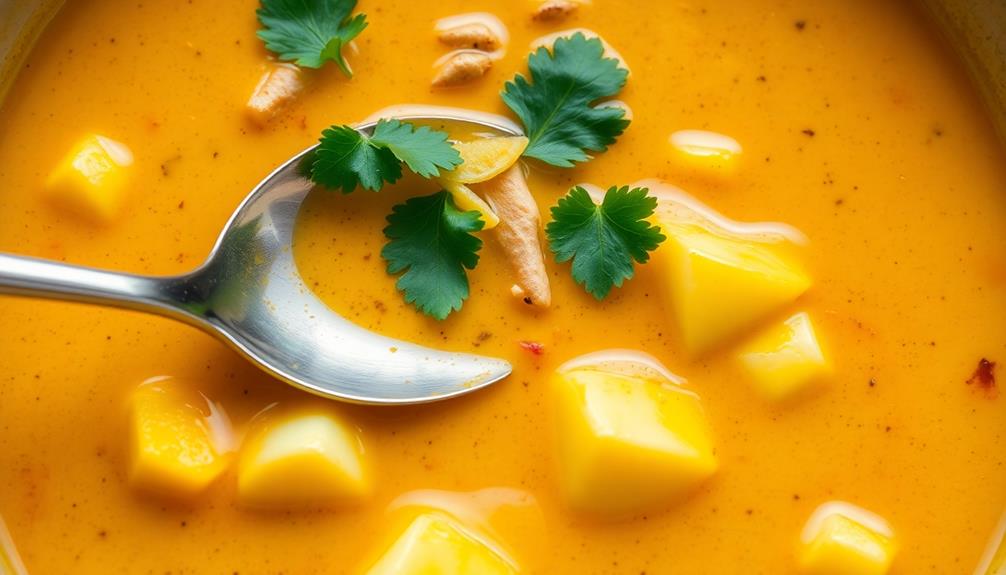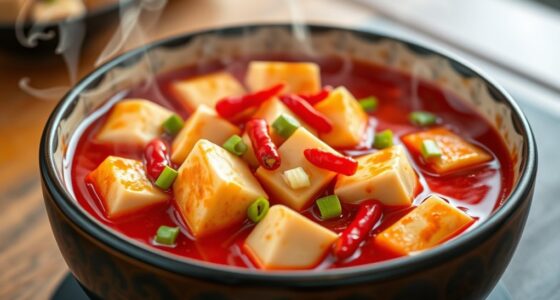Get ready to embark on a flavorful journey through the rich culinary traditions of Chinese pork belly! This iconic dish has enchanted taste buds for centuries, blending tender, fatty textures and a symphony of savory, sweet, and aromatic flavors. From the imperial courts to modern-day street markets, pork belly has cemented its place as a beloved staple in Chinese cuisine. With regional variations showcasing Cantonese and Shanghainese styles, you'll discover a world of possibilities when it comes to cooking methods, seasonings, and creative uses for this versatile ingredient. If you're eager to learn more, keep reading to uncover the secrets behind crafting a truly mouthwatering Chinese pork belly masterpiece!
Key Takeaways
- Chinese pork belly has a rich history, with distinct regional variations in cooking methods and flavors, particularly in Cantonese and Shanghainese cuisines.
- Slow braising is the key cooking technique for pork belly, yielding tender meat with a unique fatty and rich texture.
- Proper seasoning and preparation, such as scoring the skin and rubbing with spices, are crucial for achieving crispy crackling and enhancing the overall flavor profile.
- Versatile cooking methods like roasting, grilling, and stir-frying can be employed to create diverse pork belly dishes with unique textures and tastes.
- The dish offers opportunities for creativity and personalization, allowing cooks to experiment with different ingredients, spices, and cooking techniques to develop their own signature versions.
History
Tracing the origins of Chinese pork belly takes us back centuries, where this cut of meat has long been a beloved staple in the country's rich culinary traditions.
From the imperial courts of dynastic China to the bustling street markets of modern-day cities, pork belly has captivated the hearts and stomachs of generations.
Its popularity stems from the unique interplay of its fatty and tender layers, which lend themselves beautifully to a variety of cooking methods, from slow-braising to roasting.
Over time, the preparation of pork belly has evolved, with regions developing their own distinct styles and flavors, making it a versatile ingredient that can be enjoyed in countless ways.
Whether it's the crispy, caramelized edges of Cantonese roast pork or the melt-in-your-mouth, soy-infused slices of Shanghainese braised pork belly, this cherished cut has become an integral part of Chinese cuisine, transcending time and leaving an indelible mark on the country's culinary heritage.
Recipe
Pork belly is a beloved ingredient in Chinese cuisine, known for its rich, succulent texture and deep, savory flavors. This recipe for Chinese Pork Belly will guide you through the process of creating a dish that's both comforting and indulgent.
The key to achieving the perfect texture lies in the way the pork belly is cooked. By slowly braising the meat in a flavorful liquid, the fat renders down, and the meat becomes melt-in-your-mouth tender. The combination of soy sauce, rice vinegar, and a touch of sweetness creates a balanced and authentic Chinese flavor profile.
Ingredients:
- 2 lbs pork belly, skin-on and cut into 1-inch cubes
- 1/2 cup soy sauce
- 1/4 cup rice vinegar
- 1/4 cup brown sugar
- 4 cloves garlic, minced
- 2 inches ginger, peeled and sliced
- 2 cups chicken or vegetable broth
- 2 whole star anise
- 2 cinnamon sticks
- 1 tsp Sichuan peppercorns (optional)
Instructions:
In a large, heavy-bottomed pot or Dutch oven, combine the pork belly, soy sauce, rice vinegar, brown sugar, garlic, and ginger.
Pour in the broth and add the star anise, cinnamon sticks, and Sichuan peppercorns (if using). Bring the mixture to a boil, then reduce the heat to low, cover, and simmer for 2-3 hours, or until the pork is incredibly tender and the sauce has thickened.
To serve, transfer the pork belly and its sauce to a serving dish. The dish can be enjoyed on its own, over steamed rice, or as part of a larger Chinese-inspired meal.
The leftover pork belly makes an excellent filling for buns, steamed or fried, or can be incorporated into other dishes, such as noodle stir-fries or braised greens. If you’re looking to make steamed pork buns, simply chop up the leftover pork belly and combine it with your favorite seasonings and aromatics, such as garlic, ginger, and green onions. Then, use store-bought or homemade dough to wrap the filling and steam until cooked through. You can find numerous recipes and videos online that provide detailed instructions on how to make steamed pork buns.
Cooking Steps
Now, let's dive into the cooking steps!
First, you'll need to score the skin of the pork belly to help the fat render.
Next, rub the meat with a delicious spice mixture to give it tons of flavor.
Then, roast the pork at a high temperature to get that perfect crispy skin.
Don't forget to baste it with the rendered fat for extra juiciness.
Step 1. Score the Skin
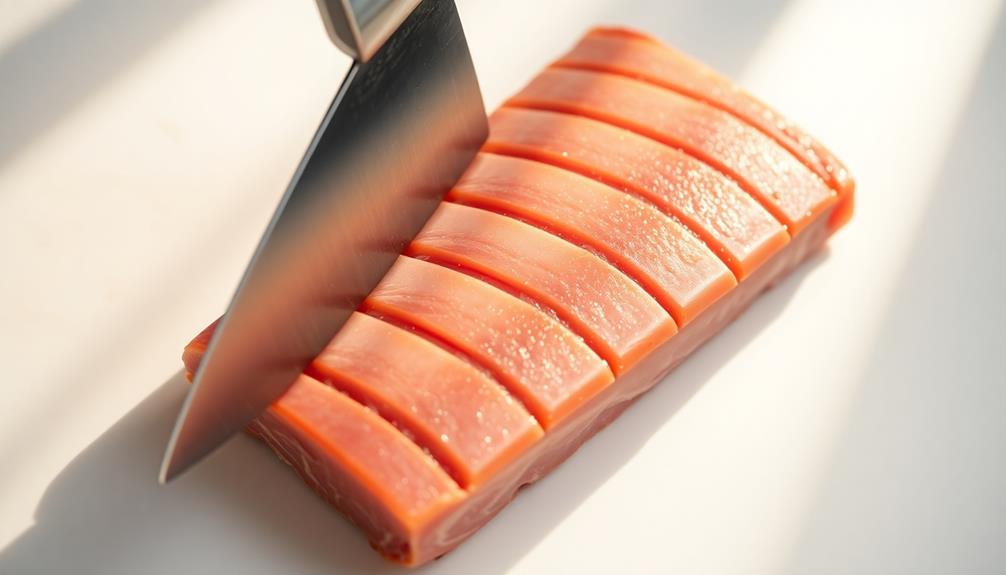
The skin's scoring is a crucial step in achieving the coveted crispy crackling. Using a sharp knife, gently score the skin in a criss-cross pattern, making sure not to cut too deeply into the meat. This creates a series of small squares that will puff up and turn golden brown as the pork belly cooks.
Be careful to keep your cuts evenly spaced, about 1/4 inch apart. Don't worry if the lines aren't perfectly straight – the irregular pattern will add to the rustic charm.
Once the skin is scored, use a paper towel to pat it dry thoroughly. This helps the fat render out and the skin to crisp up beautifully. You can also rub the skin with a bit of oil or melted lard to encourage even browning.
Just be sure not to overdo it – a light coating is all you need. With the skin prepped, you're ready to move on to the next step of roasting your delicious Chinese pork belly to perfection.
Step 2. Rub With Spice Mixture
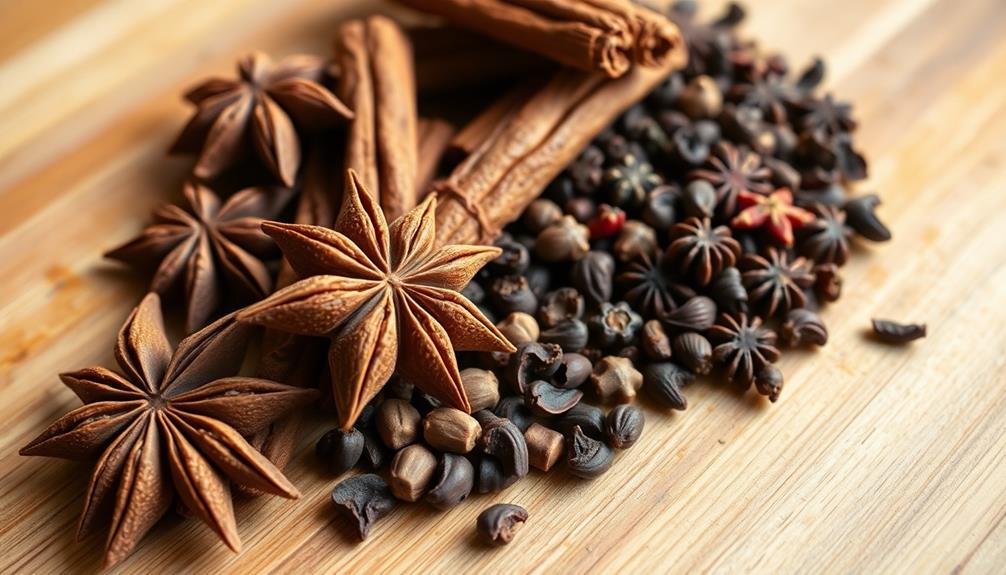
Next, generously rub the scored skin with a fragrant spice mixture. This blend of aromatic seasonings will infuse the pork with incredible flavor.
First, mix together a teaspoon each of Chinese five-spice powder, ground Sichuan peppercorns, and brown sugar. Add a dash of salt and a pinch of white pepper too. Rub this savory blend all over the skin, making sure to get it into every nook and cranny.
The sugar will help the skin get nice and crispy, while the five-spice and Sichuan pepper provide that signature Chinese flair. Once the spices are evenly distributed, let the pork sit at room temperature for 30 minutes. This allows the flavors to really seep in and tenderize the meat.
When you're ready, it's time to get that belly into the oven! The anticipation is building – just wait until you hear that satisfying crackle as the skin crisps up. Your kitchen is about to be filled with the most mouthwatering aromas.
Step 3. Roast at High Temperature

Preheat your oven to a scorching 450°F. This high heat is key to getting that irresistible crispy skin on your Chinese pork belly.
Once the oven's blazing hot, carefully place the pork belly, skin-side up, on a wire rack set over a baking sheet. This allows the fat to drip away as the meat roasts, ensuring the skin turns into a delightful crackle.
Roast the pork for 45-50 minutes, basting it with the rendered fat every 15 minutes. You'll know it's ready when the skin is golden-brown and crunchy.
Don't worry if it puffs up a bit – that just means it's working its magic!
Once it's done, let the pork rest for 10 minutes before slicing into juicy, flavor-packed pieces. Serve it up with steamed rice, sautéed veggies, and your favorite dipping sauces for a meal that'll have your taste buds doing a happy dance.
Step 4. Baste With Rendered Fat
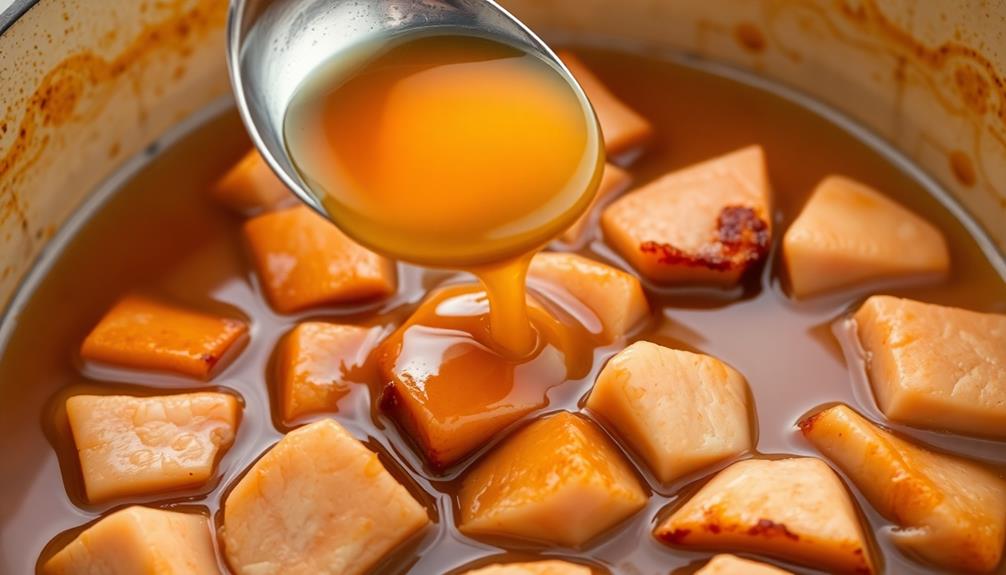
As the pork belly roasts, you'll notice the fat rendering and dripping down into the baking sheet. This is exactly what you want! Grab a spoon and start basting the pork with the flavorful fat. The more you baste, the crispier and more irresistible the skin will become.
Coat the pork generously, making sure to get the fat into all the nooks and crannies. The fat will help the spices and seasonings stick to the meat, infusing it with mouthwatering flavor.
Keep an eye on the pork and baste it every 15 minutes or so, until the skin is a gorgeous golden brown and incredibly crispy. Once the pork reaches that perfect level of crispiness, remove it from the oven and let it rest for a few minutes before slicing. The rich flavors and textures are reminiscent of a twicecooked pork traditional recipe, where the focus is on achieving tender, flavorful meat with a delightful crunch. Serve it hot, and watch as everyone eagerly reaches for seconds!
The basting process not only makes the pork belly taste amazing, but it also helps render out even more of that delicious fat. As it cooks, the fat will continue to melt, giving you plenty of juicy, savory liquid to keep basting with.
Baste, baste, baste – your taste buds will thank you!
Step 5. Let the Pork Rest
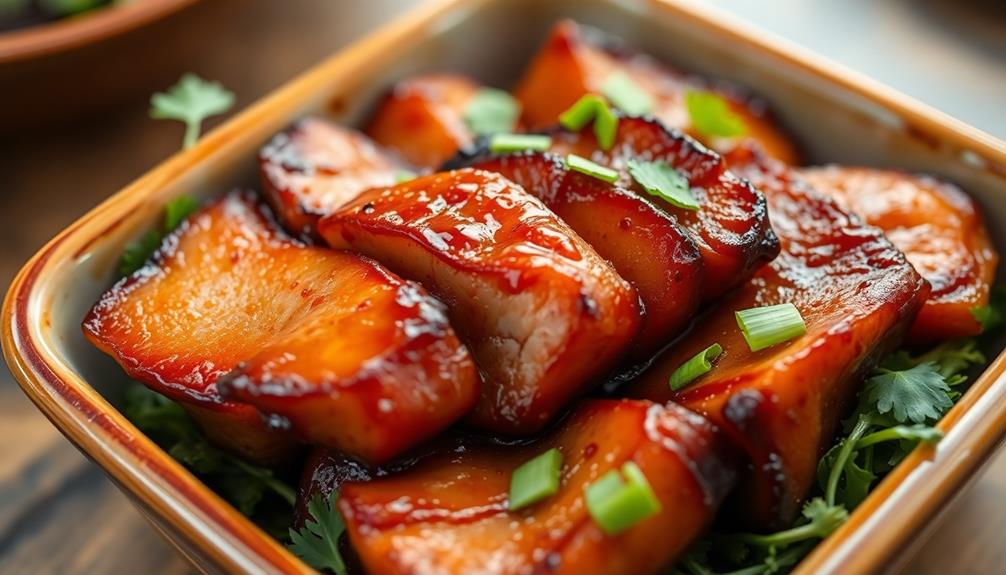
Once the pork belly has reached a deep, golden-brown hue and the skin has crisped to perfection, it's time to let it rest. This is a crucial step that allows the juices to redistribute throughout the meat, ensuring every bite is moist and bursting with flavor.
Carefully transfer the pork belly to a cutting board and let it sit for about 15 minutes. Resist the temptation to dive in right away – this patience will be rewarded!
During this resting period, the internal temperature will continue to rise a bit, and the juices will have a chance to settle.
When you're ready to serve, use a sharp knife to slice the pork belly into thick, succulent pieces. The tender, juicy meat will practically melt in your mouth, complemented by the irresistibly crispy skin.
Pair it with steamed rice, crunchy veggies, and a drizzle of the reserved cooking liquid for a true taste of Chinese culinary bliss.
Final Thoughts
Ultimately, what can you take away from this culinary adventure into Chinese pork belly?
You've learned how to expertly prepare this classic dish, from selecting the right cut to seasoning it perfectly. The key is letting the pork rest after cooking – this allows the flavors to meld and the meat to become meltingly tender.
Now that you've mastered the basics, don't be afraid to experiment!
Try adding different spices or herbs to the marinade, or experiment with different cooking methods. Maybe you'll even come up with your own signature version of Chinese pork belly.
Whichever route you choose, remember to have fun and enjoy the process. Cooking is all about exploration, and with a dish as delicious as this, the possibilities are endless.
Frequently Asked Questions
Is Pork Belly the Same as Bacon?
No, pork belly and bacon aren't the same. Pork belly is a cut of meat from the belly of a pig, while bacon is cured and smoked pork belly. Pork belly is often used in Asian cuisines, while bacon is a common breakfast meat.
How Can I Make Pork Belly Crispy?
To make pork belly crispy, you'll want to start by scoring the skin with a sharp knife. Then, pat it dry, season it well, and roast it at a high temperature until the skin crisps up nicely.
Can I Use Pork Belly in Other Dishes?
Absolutely! Pork belly is a versatile cut that can be used in all sorts of dishes beyond just crispy pork. You can braise it, roast it, or even use it in stir-fries for delicious results.
How Long Does Pork Belly Last in the Fridge?
Pork belly can last 3-5 days in the fridge when stored properly. Keep it tightly wrapped in its original packaging or in an airtight container to maintain freshness. Check for any signs of spoilage before cooking.
Is Pork Belly Healthy to Consume?
Pork belly can be a healthy addition to your diet when consumed in moderation. It's high in protein, vitamins, and minerals, but also contains saturated fats, so you'll want to watch your portion sizes.

